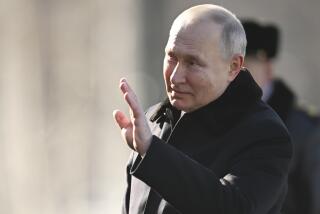Soviet Tally of Weapons in Europe Questioned; Pact May Be in Danger : Treaty: U.S. signals displeasure at how tanks, other armaments are counted. Disagreement could bring an early halt to Conventional Forces talks opening today.
- Share via
WASHINGTON — The United States signaled the Soviet Union Tuesday that negotiations on troop ceilings in Europe are jeopardized by Moscow’s interpretation of how the Conventional Forces in Europe treaty cuts the numbers of weapons such as tanks.
The new talks, aimed at reducing manpower in line with the treaty’s weapons cuts, will begin today in Vienna as scheduled, according to State Department spokeswoman Margaret Tutwiler. But after that, the North Atlantic Treaty Organization nations “could decide not to proceed,” she said.
Moscow appears to have greater need for a manpower agreement, U.S. officials said, because it is pledged to withdraw virtually all its present force, totaling 440,000 men, from East Europe by 1994. No NATO nation has comparable obligations and the Soviets presumably would prefer to work out an agreement to put a legal ceiling in place for U.S. and other forces on the continent.
The warning implied in Tutwiler’s announcement could easily be extended to other negotiating issues, including limits on short-range nuclear weapons. Those weapons also are to be discussed after the CFE treaty is finally completed.
Here, too, the Soviets have an incentive to bargain, since all Soviet battlefield nuclear weapons will be withdrawn with their forces, while the U.S. and other nuclear nations in NATO could keep their weapons in place.
Tutwiler also said Tuesday, more authoritatively than before, that the CFE treaty would not be submitted to Congress for ratification until the Soviets comply with the treaty’s obligations. Last week Secretary of State James A. Baker III said that he would recommend against sending the document to the Senate. The White House has now endorsed that position, officials said.
The treaty dispute arises primarily because of what the United States considers Moscow’s disingenuous decision to transfer three army divisions and their weapons to naval infantry, coastal defense units and strategic rocket forces. The Soviets now claim that the 3,000 tanks and other equipment in those units do not count against the weapons ceilings imposed by the treaty.
Pentagon officials tend to view the Soviet action mostly as “plain old chiseling” by the Soviet military, which has gained new influence in Moscow as the Gorbachev regime follows a harder domestic line. But other U.S. officials offer more rational reasons:
“First, the Soviet General Staff wants to remind us that naval forces are excluded from the CFE treaty, as we demanded, and they want navies covered next time,” said one State Department expert.
“And secondly, the Soviet military is now faced with defending Mother Russia without the buffer that the Warsaw Pact provided. . . . Now they can’t even rely on the Baltic states. They are wrestling with new defense doctrine and want to keep as much (weaponry in Europe) as they can get away with.”
Whatever the Soviet reason, every other nation that signed the conventional forces treaty--the six Warsaw Pact countries as well as the 16 NATO allies--rejects the Soviet interpretation and will delay their ratification proceedings on the agreement.
The Bush Administration considers the transfer issue a “treaty-buster” that could open the way to other such interpretations. Moreover, the U.S. Senate almost certainly would reject it. Officials fear that the Soviet manipulations of the conventional forces treaty would prompt Congress also to reject the Strategic Arms Reduction Treaty, when it is completed.
Efforts to resolve the controversy at high-level meetings in Geneva last week made little progress. But some optimism is being voiced because the Soviets have now offered not to use the gambit again if the three divisions can remain categorized as naval infantry. The West rejected that position but the proposal could be the first step toward a compromise.
Manpower was part of the conventional forces negotiations a few years ago. At one point, the two sides agreed to limits for the United States (225,000 men) and the Soviet Union (195,000 men). Those ceilings were “overtaken by events,” however, the negotiators decided, as the Soviets were increasingly forced to withdraw by East European nations.
The manpower issue was then formally shelved so that the rest of the treaty could be completed first. But some manpower promises were made at the last minute, not part of the treaty but ancillary to it.
Germany pledged, for instance, that its forces as a unified state would not exceed 370,000 men. Moscow then said that “in connection with” the German promise it would remove its 360,000 men from what once was East Germany.
There seems little chance that the Soviets, given their domestic turmoil, would refuse to evacuate their forces.
More to Read
Sign up for Essential California
The most important California stories and recommendations in your inbox every morning.
You may occasionally receive promotional content from the Los Angeles Times.













